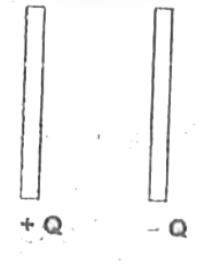STATEMENT-1: When an uncharged parallel-plate capacitor is charged by conneting it to a cell, the heat produced in the circuit is equal to the energy stored in the capacitor.
STATEMENT-1: The charge on a parallel-plate capacitor means the equal and opposite charges, on its inner surfaces.
Statement-1 is True, Statement-2 is True, Statement-2 is a correct explanation, for Statement-1.
Statement-1 is True, Statement-2 is True, Statement-2 is not a correct explanation for Statement-1.
Statement-1 is True, Statement-2 is False.
Statement-1 is a False, Statement-2 is True.
The correct Answer is:B
Topper's Solved these Questions
Similar Questions
Knowledge Check
A parallel plate capacitor is charged. If the plates are pulled apart
Athe potential difference increasesBthe capacitance increasesCthe total charge increasesDthe charge and the potential difference remain the sameA parallel plate capacitor C has a charge Q. The actual charges on its plates are
AQ,QBQ/2, Q/2CQ,-QDQ/2. - Q/2When a charged capacitor is discharged through a resistor, heat is produced in the resistor
In charging a capacitor, energy is stored in the capacitor.ABoth A and R falseBBoth A and R true and R is not correct reason for ACA is true and R is falseDBoth A and R are true and R is correct reason of A.
A parallel plate capacitor is charged and then isolated. On increasing the plate separation
View SolutionA parallel plate capacitor is charged and then isolated. On increasing the plate separation
View SolutionA parallel plate capacitor having plate area A and separation between the plates d is charged to potential V.The energy stored in capacitor is ....???
View SolutionIf the plates of a parallel plate capacitor are not equal in area then quantity of charge
View SolutionA parallel plate capacitor is charged and then isolated. On increasing the plate separation
View Solution

